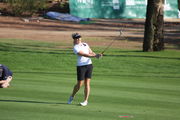
Imago
Image Courtesy: IMAGO

Imago
Image Courtesy: IMAGO
TGL has been the talk of the town lately, and while it’s faced its fair share of criticism, one thing everyone seems to agree on is the game-changing implementation of the shot clock. If you’ve caught any TGL match, you’ve probably noticed the two big shot clocks on the main video board ticking down in full view of both players and fans. And that’s not all — there are digital shot clocks scattered throughout the SoFi Center, creating a countdown that everyone can keep track of. But how viable is it for the PGA Tour? Well, if you ask Justin Thomas, not at all…
Watch What’s Trending Now!
The shot clock starts at 40 seconds, the same amount of time players are given on the PGA Tour to hit their shots. Yet there is a difference. On Tour courses, players often exceed that 40-second limit without facing any penalties. In the TGL, though, it’s a different story. The team exceeding the 40-second mark gets a one-shot penalty. Now, this is something the PGA Tour could use more of—way more than tweaking the field size, which many players aren’t on board with. But could the shot clock actually make its way to Tour events? Thomas had a clear answer for it.
After his team, Atlanta Drive GC, won their first match against New York Club GC with a score of 4-0, the question of whether the shot clock could work on the PGA Tour came up. Thomas didn’t sound too optimistic about it in a press conference on January 21. A journalist asked, “Justin, one of the things the younger fans have really taken a liking to in this league is the pace and the shot clock. Is that something you players have talked about, ever finding a way to effectively and fairly implement on a PGA TOUR level?”
ADVERTISEMENT
“It’s tough,” Thomas began.
“You have to make such drastic changes for it to be noticeable. Pretty much a lot of the conversations end the same way; it’s like, what are we trying to accomplish here? Are rounds going to be 12 minutes faster? Are they going to be 20 minutes faster? It’s hard to realistically make a big enough difference where people are like, ‘Wow, this is great. Rounds are only three hours now, or three and a half hours instead of five. You know what I mean? It’s really hard to make that big of a change.” And he’s not entirely wrong.
Just look at the Shot Clock Masters, which debuted on the European Tour in 2018. It was meant to revolutionize the game but ended up being a one-and-done event due to a lack of sponsorship and the logistical nightmare of implementing the clocks. Four penalties were handed out, but most players admitted they simply forgot the clocks were there. Introducing this system on the PGA Tour would be a huge task—not to mention expensive.
ADVERTISEMENT
It would involve hiring more rules officials or training volunteers to manage up to 54 clocks across 18 holes. Even Nick Taylor shared a similar sentiment, previously noting, “I think people would be in favor of it, but it would be an adjustment. Certain shots are not equal, like in a playoff or a putt to make the cut—now that would be interesting. But it would speed things up, no doubt.”
Still, JT made a good point about fan surveys. Fans do want faster rounds, but they also love watching players tackle tough courses. As Thomas put it, “Look, there definitely could be some things here and there that are done, but it’s also — I think there’s, like, a Fan Forward survey that the TOUR does with fans. They like harder golf courses, they like watching us play difficult places, but they want us to play faster, so those two don’t go together. You’ve kind of got to pick and choose your battles.” So, it’s all about finding the right balance.
ADVERTISEMENT
“But yeah, I guess we’ll see. I’m sure we’re all hopeful, but at the end of the day it’s like, what are we trying to accomplish. You know what I’m saying?” he concluded his answer with.
View this post on Instagram
Now while Thomas believes implementing a shot clock on the PGA Tour would be a tough challenge, some of his peers seem to think it’s not as far-fetched as he suggests.
ADVERTISEMENT
Top Stories
Scottie Scheffler Makes Critical Health Announcement After He Ended PGA Tour Hiatus

Tiger Woods & Co. Now Have to Think Twice Before Trash-Talking at TGL Following New Update

Charley Hull’s Silent Fight During Divorce Ordeal Comes to Light: ‘Went Through a Lot’

Ted Scott Reveals What ‘Boss’ Scottie Scheffler Never Lets Him Do But Bubba Watson Allowed

Golf Fans’ Reaction to Malbon’s Bold Fred Couples Decision Is Hardly Surprising

Other players have agreed on the stance of implementing a shot clock
Take Rickie Fowler, for example. When asked if there’s a TGL rule that could work in traditional golf, he didn’t hesitate. “Shot clock, no question,” he said. Fowler and the other players had no issues adjusting to the shot clock, which raises an obvious question—why not bring it to the PGA Tour? If it’s working so well in the TGL, why wouldn’t it work in Tour events?
The debut match of TGL was a real eye-opener, especially in terms of the pace of play. The 40-second shot clock seemed to make a big difference, and the players who participated were thoroughly impressed. Shane Lowry admitted he was surprised by how fast everything moved, saying, “I couldn’t believe how quickly everything happened.” Matt Fitzpatrick also echoed that sentiment, sharing, “It was much faster than I thought… I just wish that was real golf as well.”
ADVERTISEMENT
And then there’s Max Homa, who loved the energy and urgency the shot clock added to the game. He pointed out how it brought a sense of excitement and anticipation, making everything feel more dynamic and engaging. Ludvig Aberg, a member of The Bay Golf Club, chimed in too, saying, “It’s cool playing in a stadium.”
It’s clear that the shot clock isn’t just a crowd favorite; it’s also getting a thumbs-up from the players too. While players like Justin Thomas see logistical challenges, the energy and excitement it brings might just make it worth the shot. After all, isn’t the goal to keep fans and players on their toes?
ADVERTISEMENT
ADVERTISEMENT
ADVERTISEMENT

